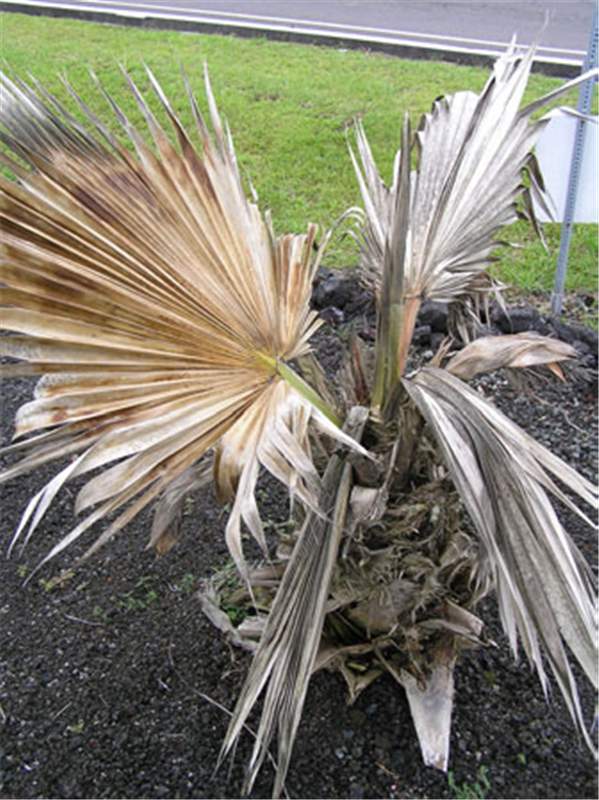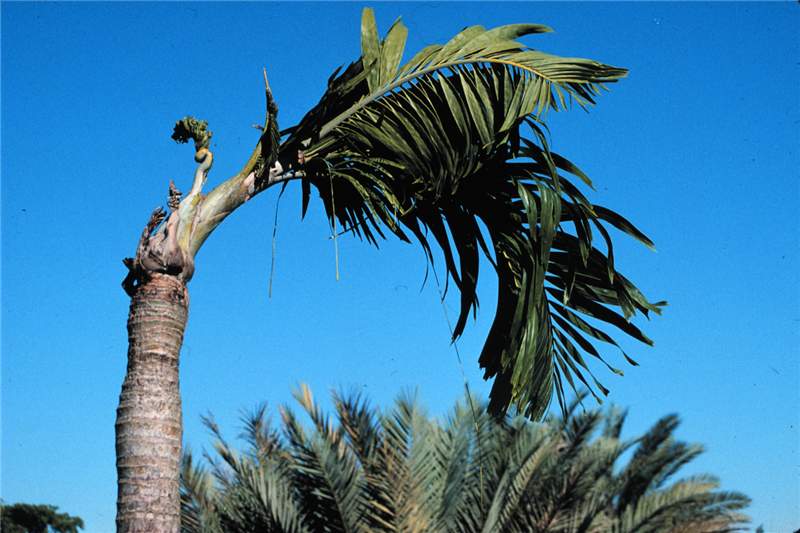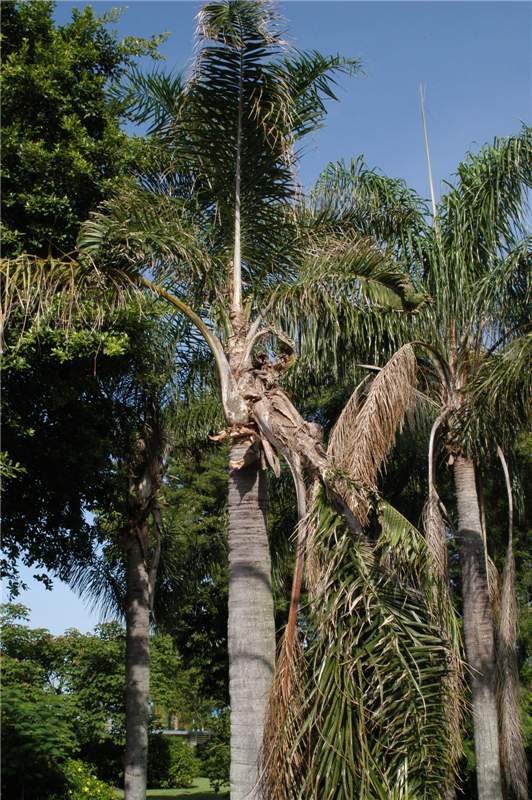Gallery
 Figure 1. Bleeding and sawdust plugs on Carpentaria acuminata trunk from ambrosia beetle feeding. Photo by T.K. Broschat.
Figure 1. Bleeding and sawdust plugs on Carpentaria acuminata trunk from ambrosia beetle feeding. Photo by T.K. Broschat.
Ambrosia Beetle Damage
Figure 1. Bleeding and sawdust plugs on Carpentaria acuminata trunk from ambrosia beetle feeding. Photo by T.K. Broschat.
Figure 1. Bleeding and sawdust plugs on Carpentaria acuminata trunk from ambrosia beetle feeding. Photo by T.K. Broschat.
Ambrosia Beetle Damage
Figure 2. Sawdust plug from ambrosia beetle on Carpentaria acuminata trunk. Photo by T.K. Broschat.
Figure 2. Sawdust plug from ambrosia beetle on Carpentaria acuminata trunk. Photo by T.K. Broschat.
 Figure 1. Damage caused by banana moth ( Opogona sacchari ) larvae in Wodyetia bifurcata . Photo by T.K. Broschat
Figure 1. Damage caused by banana moth ( Opogona sacchari ) larvae in Wodyetia bifurcata . Photo by T.K. Broschat
Banana Moth Larvae Damage
Figure 1. Damage caused by banana moth (Opogona sacchari) larvae in Wodyetia bifurcata. Photo by T.K. Broschat
Figure 1. Damage caused by banana moth (Opogona sacchari) larvae in Wodyetia bifurcata. Photo by T.K. Broschat
Banana Moth Larvae Damage
Figure 2. Palm killed by Opogona sacchari. Photo by Scot Nelson.
Figure 2. Palm killed by Opogona sacchari. Photo by Scot Nelson.
 Figure 3. Damage caused by Opogona sacchari on adult coconut palm ( Cocos nucifera ). Photo by T.K. Broschat.
Figure 3. Damage caused by Opogona sacchari on adult coconut palm ( Cocos nucifera ). Photo by T.K. Broschat.
Banana Moth Larvae Damage
Figure 3. Damage caused by Opogona sacchari on adult coconut palm (Cocos nucifera). Photo by T.K. Broschat.
Figure 3. Damage caused by Opogona sacchari on adult coconut palm (Cocos nucifera). Photo by T.K. Broschat.
 Figure 1. Holes in trunk of Washingtonia filifera caused by Dinapate wrightii . Photo by T.K. Broschat
Figure 1. Holes in trunk of Washingtonia filifera caused by Dinapate wrightii . Photo by T.K. Broschat
Borer Damage
Figure 1. Holes in trunk of Washingtonia filifera caused by Dinapate wrightii. Photo by T.K. Broschat
Figure 1. Holes in trunk of Washingtonia filifera caused by Dinapate wrightii. Photo by T.K. Broschat
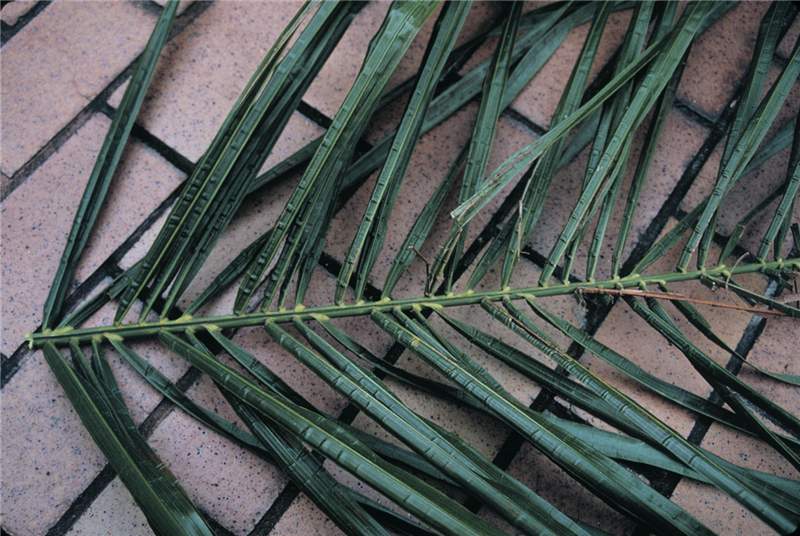 Figure 1. Transverse puckering in Syagrus romanzoffiana , a symptom of mild B deficiency. Photo by T.K. Broschat
Figure 1. Transverse puckering in Syagrus romanzoffiana , a symptom of mild B deficiency. Photo by T.K. Broschat
Boron Deficiency
Figure 1. Transverse puckering in Syagrus romanzoffiana, a symptom of mild B deficiency. Photo by T.K. Broschat
Figure 1. Transverse puckering in Syagrus romanzoffiana, a symptom of mild B deficiency. Photo by T.K. Broschat
 Figure 2. Zigzag shaped leaflet tips (quot;hookleafquot;) in Cocos nucifera is caused by a mild and temporary B deficiency. Photo by T.K. Broschat
Figure 2. Zigzag shaped leaflet tips (quot;hookleafquot;) in Cocos nucifera is caused by a mild and temporary B deficiency. Photo by T.K. Broschat
Boron Deficiency
Figure 2. Zigzag shaped leaflet tips ("hookleaf") in Cocos nucifera is caused by a mild and temporary B deficiency. Photo by T.K. Broschat
Figure 2. Zigzag shaped leaflet tips ("hookleaf") in Cocos nucifera is caused by a mild and temporary B deficiency. Photo by T.K. Broschat
 Figure 3. Leaf tip of Syagrus romanzoffiana devoid of leaflets, a symptom of B deficiency. Photo by T.K. Broschat
Figure 3. Leaf tip of Syagrus romanzoffiana devoid of leaflets, a symptom of B deficiency. Photo by T.K. Broschat
Boron Deficiency
Figure 3. Leaf tip of Syagrus romanzoffiana devoid of leaflets, a symptom of B deficiency. Photo by T.K. Broschat
Figure 3. Leaf tip of Syagrus romanzoffiana devoid of leaflets, a symptom of B deficiency. Photo by T.K. Broschat
 Figure 4. Leaf truncation in Cocos nucifera caused by periodic temporary B deficiency. This pattern was the result of heavy rainfall events approximately every 10 days during the development of the leaf in the center. Photo by T.K. Broschat
Figure 4. Leaf truncation in Cocos nucifera caused by periodic temporary B deficiency. This pattern was the result of heavy rainfall events approximately every 10 days during the development of the leaf in the center. Photo by T.K. Broschat
Boron Deficiency
Figure 4. Leaf truncation in Cocos nucifera caused by periodic temporary B deficiency. This pattern was the result of heavy rainfall events approximately every 10 days during the development of the leaf in the center. Photo by T.K. Broschat
Figure 4. Leaf truncation in Cocos nucifera caused by periodic temporary B deficiency. This pattern was the result of heavy rainfall events approximately every 10 days during the development of the leaf in the center. Photo by T.K. Broschat
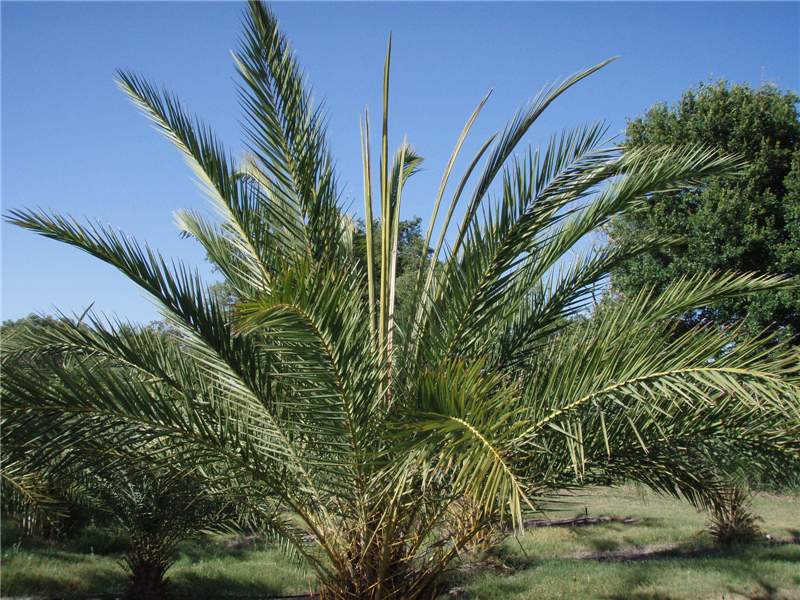 Figure 5. Multiple unopened spear leaves in Phoenix sylvestris caused by chronic B deficiency. Photo by T.K. Broschat
Figure 5. Multiple unopened spear leaves in Phoenix sylvestris caused by chronic B deficiency. Photo by T.K. Broschat
Boron Deficiency
Figure 5. Multiple unopened spear leaves in Phoenix sylvestris caused by chronic B deficiency. Photo by T.K. Broschat
Figure 5. Multiple unopened spear leaves in Phoenix sylvestris caused by chronic B deficiency. Photo by T.K. Broschat
Boron Deficiency
Figure 6. Trunk bending in Adonidia merrillii caused by B deficiency. Photo by T.K. Broschat
Figure 6. Trunk bending in Adonidia merrillii caused by B deficiency. Photo by T.K. Broschat
Boron Deficiency
Figure 7. Severe epinasty in Roystonea regia caused by chronic B deficiency. Photo by T.K. Broschat
Figure 7. Severe epinasty in Roystonea regia caused by chronic B deficiency. Photo by T.K. Broschat
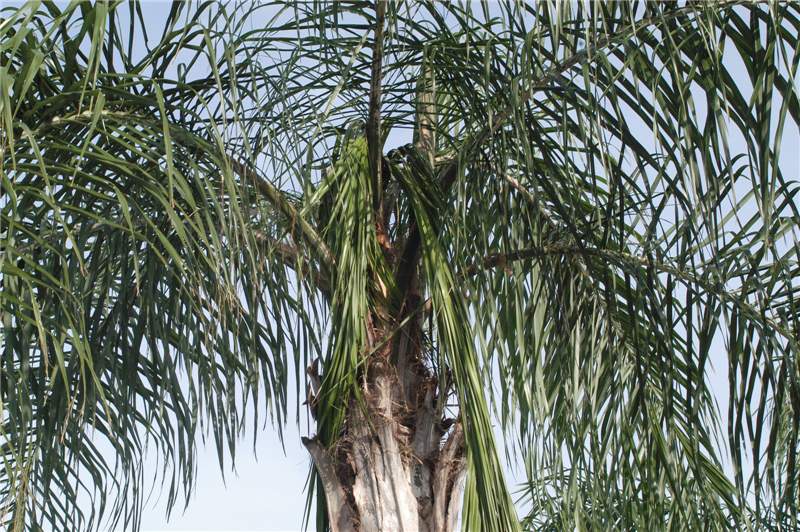 Figure 8. New leaves growing downward in Syagrus romanzoffiana caused by boron deficiency. Photo by T.K. Broschat.
Figure 8. New leaves growing downward in Syagrus romanzoffiana caused by boron deficiency. Photo by T.K. Broschat.
Boron Deficiency
Figure 8. New leaves growing downward in Syagrus romanzoffiana caused by boron deficiency. Photo by T.K. Broschat.
Figure 8. New leaves growing downward in Syagrus romanzoffiana caused by boron deficiency. Photo by T.K. Broschat.
Boron Deficiency
Figure 9. Branching in Syagrus romanzoffiana caused by boron deficiency. Photo by T.K. Broschat
Figure 9. Branching in Syagrus romanzoffiana caused by boron deficiency. Photo by T.K. Broschat
Boron Deficiency
Figure 10. Corrugated leaf of queen palm caused by B deficiency. Photo by T.K. Broschat
Figure 10. Corrugated leaf of queen palm caused by B deficiency. Photo by T.K. Broschat
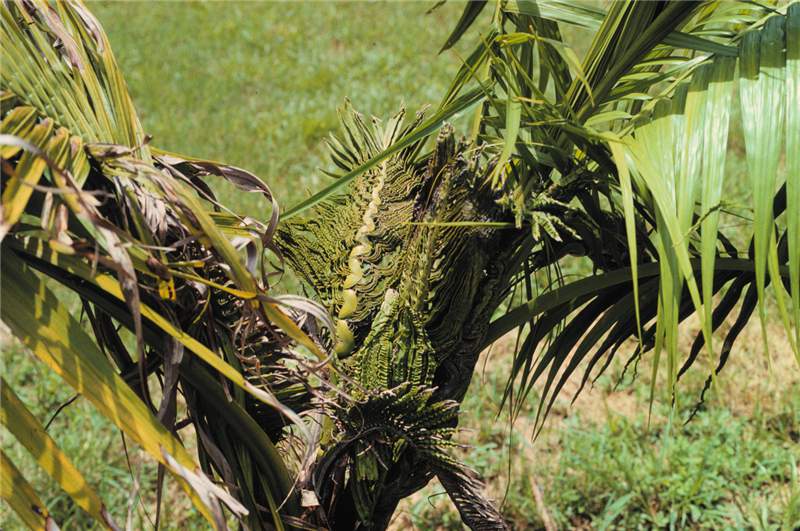 Figure 11. Crumpled new leaves (quot;accordion-leafquot;) on Heterospathe elata caused by severe B deficiency. Photo by T.K. Broschat.
Figure 11. Crumpled new leaves (quot;accordion-leafquot;) on Heterospathe elata caused by severe B deficiency. Photo by T.K. Broschat.
Boron Deficiency
Figure 11. Crumpled new leaves ("accordion-leaf") on Heterospathe elata caused by severe B deficiency. Photo by T.K. Broschat.
Figure 11. Crumpled new leaves ("accordion-leaf") on Heterospathe elata caused by severe B deficiency. Photo by T.K. Broschat.
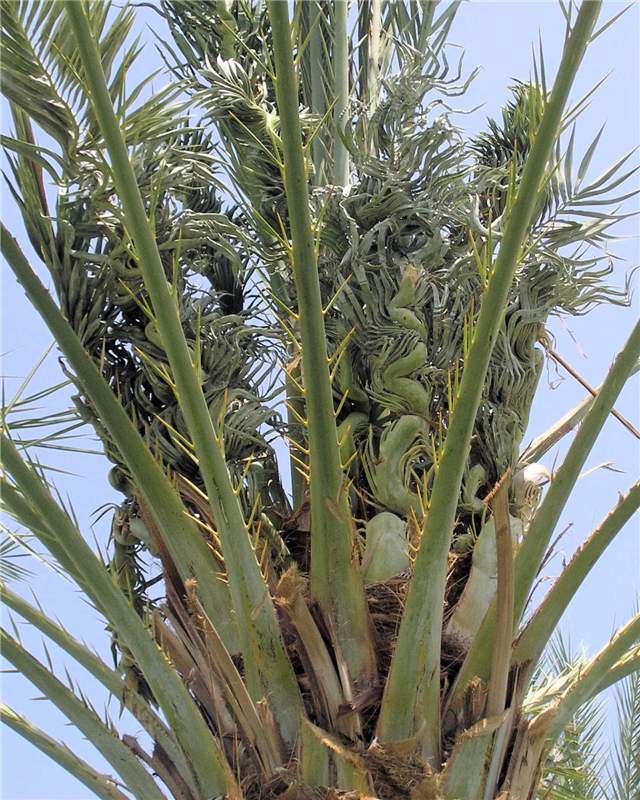 Figure 12. Crumpled (quot;accordion-leafquot;) young leaves of Phoenix dactylifera caused by a chronic and severe B deficiency. Note that the youngest leaf is emerging normally, indicating that this palm is recovering. Photo by T.K. Broschat
Figure 12. Crumpled (quot;accordion-leafquot;) young leaves of Phoenix dactylifera caused by a chronic and severe B deficiency. Note that the youngest leaf is emerging normally, indicating that this palm is recovering. Photo by T.K. Broschat
Boron Deficiency
Figure 12. Crumpled ("accordion-leaf") young leaves of Phoenix dactylifera caused by a chronic and severe B deficiency. Note that the youngest leaf is emerging normally, indicating that this palm is recovering. Photo by T.K. Broschat
Figure 12. Crumpled ("accordion-leaf") young leaves of Phoenix dactylifera caused by a chronic and severe B deficiency. Note that the youngest leaf is emerging normally, indicating that this palm is recovering. Photo by T.K. Broschat
Boron Deficiency
Figure 13. Inflorescence necrosis on B-deficient Sygrus romanzoffiana. Photo by T.K. Broschat
Figure 13. Inflorescence necrosis on B-deficient Sygrus romanzoffiana. Photo by T.K. Broschat
Boron Deficiency
Figure 14. Premature fruit drop in Cocos nucifera caused by B deficiency.Photo by T.K. Broschat
Figure 14. Premature fruit drop in Cocos nucifera caused by B deficiency.Photo by T.K. Broschat
Bud Rot
Figure 1. The spear leaf of this seedling palm has already died due to a bud rot pathogen. While the surrounding leaves appear healthy, the bud (apical meristem) of this palm has already rotted, and no new growth will occur. Photo by M. L. Elliott.
Figure 1. The spear leaf of this seedling palm has already died due to a bud rot pathogen. While the surrounding leaves appear healthy, the bud (apical meristem) of this palm has already rotted, and no new growth will occur. Photo by M. L. Elliott.
Bud Rot
Figure 2. The spear leaf and next youngest leaves of this juvenile palm are exhibiting extensive necrosis due to a bud rot pathogen. Photo by M. L. Elliott.
Figure 2. The spear leaf and next youngest leaves of this juvenile palm are exhibiting extensive necrosis due to a bud rot pathogen. Photo by M. L. Elliott.
Bud Rot
Figure 3. The spear leaf and the next youngest leaves are desiccated and necrotic due to bud rot. Photo by M. L. Elliott.
Figure 3. The spear leaf and the next youngest leaves are desiccated and necrotic due to bud rot. Photo by M. L. Elliott.
Bud Rot
Figure 4. The spear leaf and the next youngest leaves are desiccated and necrotic due to bud rot. Photo by M. L. Elliott.
Figure 4. The spear leaf and the next youngest leaves are desiccated and necrotic due to bud rot. Photo by M. L. Elliott.
Bud Rot
Figure 5. The initial site of infection is on the unopened leaf blade of the spear leaf. Photo by M. L. Elliott.
Figure 5. The initial site of infection is on the unopened leaf blade of the spear leaf. Photo by M. L. Elliott.
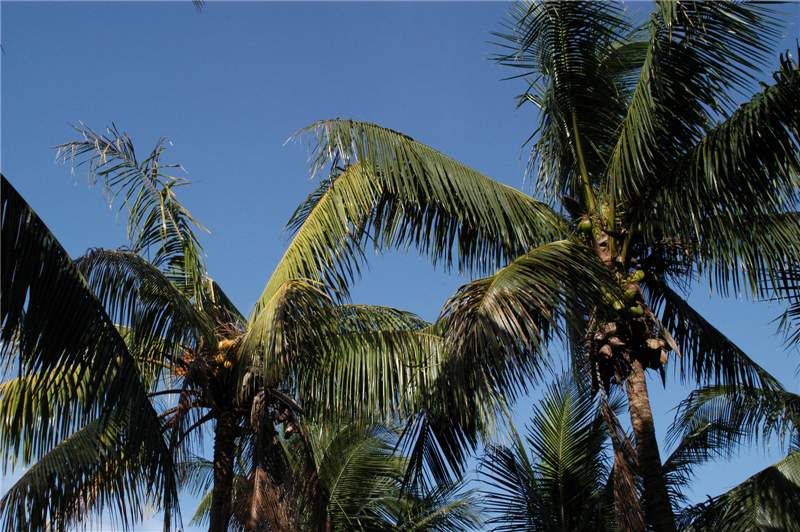 Figure 6. The Cocos nucifera on the left side of this photograph had the spear leaf and surrounding youngest leaves die from a bud rot pathogen months prior to this photograph. These leaves have fallen out of the palm canopy. No new leaves have emerged because the bud (apical meristem) has also died. The Cocos nucifera on the right is a healthy palm. Photo by M. L. Elliott
Figure 6. The Cocos nucifera on the left side of this photograph had the spear leaf and surrounding youngest leaves die from a bud rot pathogen months prior to this photograph. These leaves have fallen out of the palm canopy. No new leaves have emerged because the bud (apical meristem) has also died. The Cocos nucifera on the right is a healthy palm. Photo by M. L. Elliott
Bud Rot
Figure 6. The Cocos nucifera on the left side of this photograph had the spear leaf and surrounding youngest leaves die from a bud rot pathogen months prior to this photograph. These leaves have fallen out of the palm canopy. No new leaves have emerged because the bud (apical meristem) has also died. The Cocos nucifera on the right is a healthy palm. Photo by M. L. Elliott
Figure 6. The Cocos nucifera on the left side of this photograph had the spear leaf and surrounding youngest leaves die from a bud rot pathogen months prior to this photograph. These leaves have fallen out of the palm canopy. No new leaves have emerged because the bud (apical meristem) has also died. The Cocos nucifera on the right is a healthy palm. Photo by M. L. Elliott
Bud Rot
Figure 8. Spore mass of Nalanthamala vermoesenii (=Gliocladium vermoesenii) on spear leaf tissue. Photo by M. L. Elliott
Figure 8. Spore mass of Nalanthamala vermoesenii (=Gliocladium vermoesenii) on spear leaf tissue. Photo by M. L. Elliott
 Figure 1. Feeding damage caused by saddleback caterpillars ( Acharia stimulea ). Photo by T.K. Broschat.
Figure 1. Feeding damage caused by saddleback caterpillars ( Acharia stimulea ). Photo by T.K. Broschat.
Caterpillar Feeding Damage
Figure 1. Feeding damage caused by saddleback caterpillars (Acharia stimulea). Photo by T.K. Broschat.
Figure 1. Feeding damage caused by saddleback caterpillars (Acharia stimulea). Photo by T.K. Broschat.
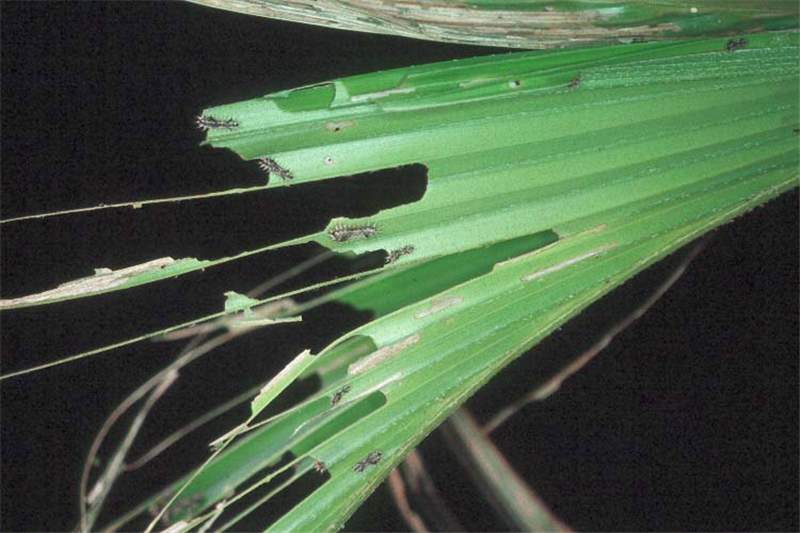 Figure 2. Typical damage caused by nettle caterpillars ( Darna pallivitta ) feeding. Photo by Hawaii Dept. of Agriculture.
Figure 2. Typical damage caused by nettle caterpillars ( Darna pallivitta ) feeding. Photo by Hawaii Dept. of Agriculture.
Caterpillar Feeding Damage
Figure 2. Typical damage caused by nettle caterpillars (Darna pallivitta) feeding. Photo by Hawaii Dept. of Agriculture.
Figure 2. Typical damage caused by nettle caterpillars (Darna pallivitta) feeding. Photo by Hawaii Dept. of Agriculture.
Coconut Mite Damage
Figure 1. Coconut mite damage on fruits of coconut. Photo by T.K. Broschat.
Figure 1. Coconut mite damage on fruits of coconut. Photo by T.K. Broschat.
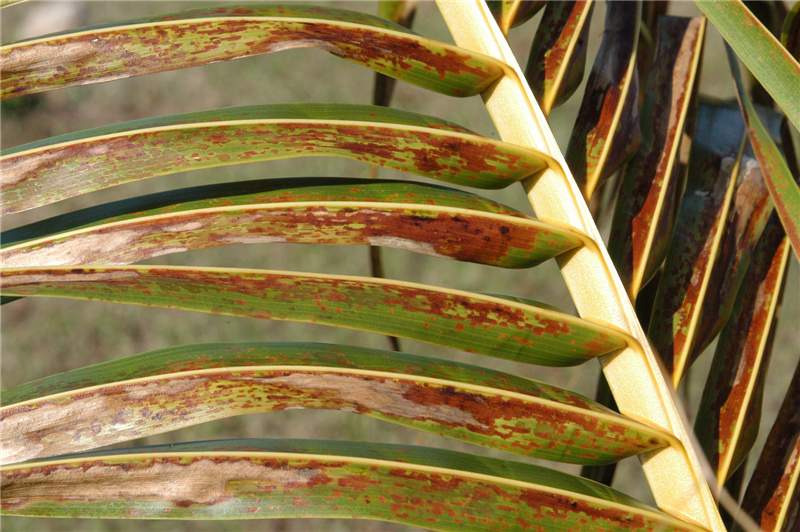 Figure 1. Mild chilling injury symptoms on leaf of Cocos nucifera showing reddish blotches on the top of the leaflets. Photo by T.K. Broschat.
Figure 1. Mild chilling injury symptoms on leaf of Cocos nucifera showing reddish blotches on the top of the leaflets. Photo by T.K. Broschat.
Cold Damage
Figure 1. Mild chilling injury symptoms on leaf of Cocos nucifera showing reddish blotches on the top of the leaflets. Photo by T.K. Broschat.
Figure 1. Mild chilling injury symptoms on leaf of Cocos nucifera showing reddish blotches on the top of the leaflets. Photo by T.K. Broschat.
Cold Damage
Figure 2. Chilling injury on Geonoma sp. showing foliar necrosis. Photo by T.K. Broschat.
Figure 2. Chilling injury on Geonoma sp. showing foliar necrosis. Photo by T.K. Broschat.



